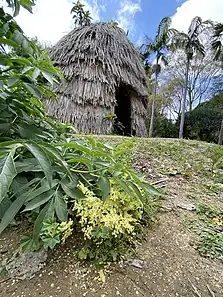Tovaangar
Tovaangar (Tongva: "the world")[1][2] refers to the Tongva world or homelands. It includes the greater area of the Los Angeles Basin, including the San Gabriel Valley, San Fernando Valley, northern Orange County, parts of San Bernardino County and Riverside County, and the southern Channel Islands, including San Nicholas, Santa Catalina, Santa Barbara, and San Clemente.[3][4][5] The homelands of the Chumash are to the northwest, the Tataviam to the north, the Serrano and Cahuilla to the east, and the Acjachemen and Payómkawichum to the south.[3]

Travel
Prior to European colonialism, land travel through Tovaangar largely occurred through an extensive network of trails traveled by Indigenous peoples throughout the region. Although not often recognized by name, many of these trails became roads and highways that are now used for automobile travel.[7] One of the most significant was the Mohave trail, which connected Tovaangar to nations in the east along, what the Spanish referred to as, the Colorado River.[8]
Travel over water mainly occurred through tule reed boats for local travel through waterways. For ocean travel, particularly between the mainland and the villages on Pimuu'nga, Kinkipar, and Haraasnga, te'aats or ti'ats were common. These are wooden plank boats still built by the Tongva currently in the Ti'at Society that are made air tight with a mixture of asphaltum and hold up to twelve people. A similar boat is the Chumash tomol. The Tongva and Chumash are unique in being the only two nations in the region with plank canoes of this kind.[9][6]
Land
After the establishment of Spanish missions in California and the California genocide, all of Tovaangar has been taken out of the Tongva's stewardship. The Tongva Taraxat Paxaavxa Conservancy has been established for the rematriation of Tongva homelands.[10] In 2022, a 1-acre site was returned to the conservancy in Altadena, which marked the first time the Tongva had land under their stewardship in Los Angeles County in nearly two-hundred years.[10]
Villages
San Fernando Valley
- Achooykomenga
- Ashaawanga
- Cahuenga
- Ceegenga
- Momonga
- Muhunga
- Okowvinjha
- Pakoinga
- Pasheeknga
- Pimocagna
- Puntitavjatngna
- Quapa
- Saway-yanga
- Sheshiikuanungna
- Siutcanga
- Totonga
- Tuyunga
Outskirts
- Jucjauynga
- Juyunga
- Najabatanga
- Puninga
- Wikangna
San Gabriel Valley
- Alyeupkigna
- Awigna
- Azucsagna
- Hahamongna
- Isanthcogna
- Jajamonga
- Momwahomomutngna
- Pemookangna
- Shevaanga
- Sibanga
- Sonagna
- Tooypinga
- Torojoatngna
- Toviscanga
- Uchibit
- Weniinga
Outskirts
- Haramoknga
- Joatngna
San Bernardino County
- Homhoangna
- Horuuvnga
- Kaawchama
- Kuukamonga
- Pasinogna
- Wa'atsngna
- Wapijanga
Riverside County
- Horuuvngna
- Pahavgna
- Paxauxa
- Shiishongna
Channel Islands
- Haraasnga
- Xaraashnga
- Kinkipar
- Guinguina
- Pimuu'nga
- Naayxoxar
- Pipiimar
- Tchunashngna
References
- "On Tovaangar | PRIME". On Tovaangar | PRIME. Retrieved 2023-01-01.
- Stewart-Ambo, Theresa (2021). "The Future Is in the Past: How Land-Grab Universities Can Shape the Future of Higher Education". Native American and Indigenous Studies. 8 (1): 162–168. doi:10.1353/nai.2021.a784830. ISSN 2332-127X.
- Vaughn, Kēhaulani Natsuko; Ambo, Theresa Jean (2022-08-01). "Trans-Indigenous Education: Indigeneity, Relationships, and Higher Education". Comparative Education Review. 66 (3): 508–533. doi:10.1086/720611. ISSN 0010-4086. S2CID 249728456.
- Hackel, Steven W.; Zerneke, Jeanette; Zappia, Natale. "Early California Cultural Atlas: Visualizing Uncertainties within Indigenous History". Visualizing Uncertainties Within Indigenous History. doi:10.4324/9780429295546-8-9. ISBN 9780429295546. S2CID 164246246. Retrieved 2023-01-01.
{{cite book}}:|work=ignored (help) - "Tongva, Los Angeles' first language, opens the door to a forgotten time and place". Los Angeles Times. 2019-05-09. Retrieved 2023-01-01.
- "S2 E1: Rethinking the Coast with the Ti'at Society". KCETOnline, YouTube. 4 November 2019. Retrieved 7 October 2020.
- Day, Mark R. (13 September 2018). "Aboriginal Pathways and Trading Routes Were California's First Highways". ICT. Retrieved 2023-01-02.
- Zappia, Natale A. (2014). Traders and raiders : the indigenous world of the Colorado Basin, 1540-1859. Chapel Hill. p. 77. ISBN 978-1-4696-1585-1. OCLC 883632043.
{{cite book}}: CS1 maint: location missing publisher (link) - Hein, Frank J. (2013). Wild Catalina Island : natural secrets and ecological triumphs. Carlos L. de la Rosa. Charleston, SC. ISBN 978-1-61423-918-5. OCLC 944514536.
{{cite book}}: CS1 maint: location missing publisher (link) - "After nearly 200 years, the Tongva community has land in Los Angeles County". Los Angeles Times. 2022-10-10. Retrieved 2023-01-03.
